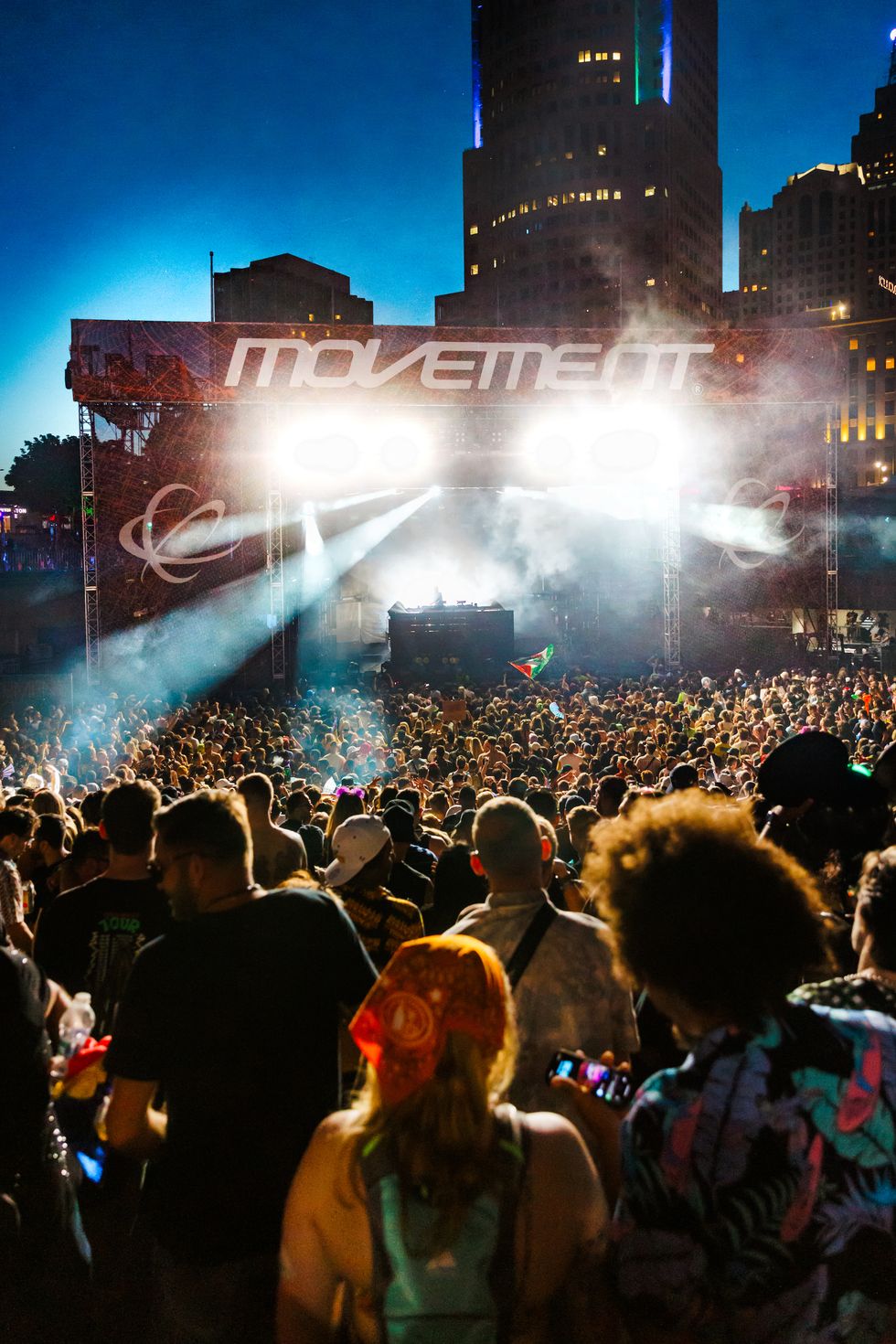
The Past, Present and Fervor of Techno at Movement Fest
By Tobias Hess
Jun 06, 2024I was looking out from my hotel room towards the concrete horizon when the gurgling sound of bass began to emanate from below. It was my first time in Detroit, and I was tempted to ruminate on the big things — industrialization, capitalism, gentrification. Necessity, though, was beckoning me towards the practical, namely how my body was going to sustain itself for three days of relentless bliss at Movement Festival, the three-day techno marathon that has become a yearly pilgrimage for savants around the world.
As longtime Detroiters told me, Movement Festival, or rather the Memorial Day festival in Hart Plaza of many names, used to be free. Detroit Electronic Music Festival was started in 2000 by Carol Marvin and her organization Pop Culture Media, alongside legendary techno artist and Detroit native Carl Craig. A 2001 recap of Focus Detroit Electronic Music Festival (its next name) shows central figures from techno’s early days, such as Stacey Pullen. “[Detroit is] the birthplace of the music,” Pullen said back then. “It’s about educating the city and educating the people and just making it happen.”
The prospect of celebrating techno in the city that birthed it made the festival an irresistible draw to thousands of the genre’s initiated and proud Detroiters. But while the festival drew massive crowds in its first years, it failed to turn a profit and faced deep challenges, from the end of the City’s support (hence its once free price) to Michigan’s unpredictable spring weather. “There really wasn't a blueprint,” Jason Huavere told me. Huavere’s company, Paxahau, has independently managed the Festival since 2006. “There was Lollapalooza [in near-ish-by Chicago], but that was way on the commercial side of things,” he shared. Europe had more established electronic music festivals, but this was essentially a first for North America. Paxahau’s job was to find a model that worked, and in Huvaere’s words, “stabilize” the entire sprawling endeavor.

Over a decade since they took over, the festival has maintained its huge size and become a focal point for the global electronic music community. The scale of Movement also means the city’s artists, organizers and venues can build off the influx. “Movement has made an entire economy in Detroit,” Brendan M. Gillen told me over the phone a week after the weekend’s festivities. Gillen, who founded and runs the label and event series Interdimensional Transmission, organizes Return To The Source, the long-running Memorial Day weekend party at staple club Tangent Gallery. “It's a totally symbiotic relationship [between our party and Movement Festival] because they're doing something that reaches the entire public. This is an extremely rare time where the population of Detroit quadruples.”
“For [Texture], it's not really possible to do a 1,000 plus party in Detroit any other weekend of the year,” Texture co-founder and organizer Jacob Park, shared with me, echoing Gillen’s point. “Movement festival is a huge facilitator for Memorial Day weekend in Detroit, which has evolved into an annual gathering for so many different scenes and crews from across North America. It feels a lot like a family reunion."
I felt that immediately upon my arrival: a giddiness and a sense of familial fervor, except instead of blood relation, it was the spiritual bind of techno and its affiliates that united these cliques of comrades. With three days of never-ending dancing and debauchery on my docket, it was my task to try and see and hear as much as I could within that one spiraling city.
I began to circle down that drain.

The prospect of capturing the weekend was overwhelming, if not impossible. The type-A striver within me had a meticulous document with set times, breaks pre-planned and a planned-out map. But as soon as I entered Hart Plaza, I knew that I’d have to relent and let the wind take me.
On Saturday, I focused on the many legacy acts the festival featured, such as Floorplan, the cross-generational project of Lyric Hood and her father, Robert Hood, the legendary creator of minimalist techno. I saw them on Saturday, nestled up against the front of the Pyramid Stage. Floorplan’s set was much lighter and warmer than much of Robert’s solo work, which is known for its relative starkness and severity. With Gospel samples that mirrored Robert’s own deepened faith, there was a sense of familiarity and rootedness there. Yes, because of the daughter-father duo, but also because Hood is Detroit royalty, and Movement felt like the homecoming techno’s progenitors deserve.
I also made space to be surprised. One early highlight was Julia Govor, who played Underground Stage, a great expanse of subterranean concrete beneath the plaza. Govor’s set quickly cemented Underground Stage as my favorite space in the festival. The Georgia-born, New York City-based DJ’s mix was eclectic, modulating between hypnotic textures and propulsive modular synths. Moving through the thick crowd, I ended up bathed in purple light and surrounded by sweaty bodies as the afternoon warmth was peaking.
That was the sort of euphoric energy I sought in the night’s afterparties. After a quick rest in the hotel room and some creative tussling with Uber’s surge pricing, I found myself at one queer party I promised not to mention by name, so as to not tip the party beyond its already strained capacity. A steamy, sexy, bodily affair, it was a welcome dose of DIY chaos after a day that, while fun, did have the necessary safety of a corporate-backed endeavor.
I couldn’t stay too long, though. I was set to spend the evening at Texture, the Memorial Day Weekend edition of the long-running party series by Jacob Park and light artist Patrick Ethen. Hosted in the brand new Lincoln Factory, a gargantuan new warehouse venue by the team behind Detroit-staple Marble Bar, the space was lit in red light, a hallmark of Park and Ethen who have a particularly spatially attuned approach to party-making. I floated between the downstairs warehouse and upstairs barebones rooftop deck, catching sets by favs like Darwin, Roza Terenzi and livwutang, as the sky morphed purple and then orange and finally blue.

After a day of hibernation, I tepidly re-entered the world to sheepishly fumble towards the festival grounds. After entering, I found myself at Hector Oak’s uproarious vinyl set in the burrows of the Underground Stage, swirling back again in that whirl of darkness. But when I left, I felt the cool pricks of raindrops coming from the sky. I was prepped and ready to see some of my favs, namely Avalon Emerson and Floating Points, but the trickle turned into a pour, which turned into a festival-wide call to evacuate due to the imminence of lightning.
The whole festival was put on ice. As I scurried back to the hotel room, I heard a number of attendees make frenzied plans to keep the party going. “Party on the 25th floor,” said one wide-eyed bro in my elevator. But I skipped the Marriott rave and chose to dry off in my hotel room, instead opting to nervously look at my phone for confirmation that the festivities would begin again.
It had the potential to be a low point of the festival. Of course, it’s a bummer to miss so much music, but Huvaere told me it was a surprising opportunity to see the crowd’s dedication. Around 10 PM (just two hours prior to the festival’s scheduled closure for the night), attendees were notified via social media that doors were opening. Over 10,000 festival goers would find their way back, and 200 staff stayed on through the rain in anticipation of the ability to re-open the stages. “Detroit loves a comeback story,” Huvaere offered.
The rain was still pecking us, but it was manageable, allowing me to somewhat sleepily regard a DJ set by James Blake from the back of the crowd. His music is always surprising and smartly crafted and I swayed knowingly along, even as my clothes were dampening underneath the clouds. I also saw a bit of Richie Hawtin, a local Detroit legend whose brand of high-minded techno and propulsive synth work helped usher techno from the physical to the digital age. Energetic as it was, the night before and the weather had me weary, so I made my way towards the Pyramid stage to see what I could of actor Idris Elba’s b2b set with Kevin Saunderson. Skeptically, I entered the packed mass of bodies and found them singing along to “Sweet Dreams (Are Made of These)” by Eurythmics. All love to the legends, but I took the song and its theme as my signal to make my way to my hotel and have my own sweet slumber.

The weekend was wearing on, but I still had much to witness. On Monday, I parked myself at Waterfront Stage to see a series of legends from across the pond. LTJ Bukem, one of the key figures behind Drum ‘n’ Bass, played a set that was vibrant and fluid. His signature breakbeat drums glided across the field, as he was accompanied by the MC Armanni Reign, who performed great feats of vocal acrobatics over the lightspeed beats, chopping up his voice into quicked staccato patterns that swung between intelligibility and pure musicality. Armanni Reign also joined Goldie, another British Drum ‘n’ Bass legend, who played right after. Like LTJ Bukem, this set pounded with a swirling velocity, though this one with a touch more aggression, punctuated by veering synths that skirted through the crowd.
I also saw Hiroko Yamamura, the Chicago stalwart whose set had a cybernetic, industrial quality. Swaying at the Stargate stage, no one looked cooler the entire weekend as Yamamura alternated between chiefing cigs, sipping her drink and executing a mix that was as diverse as it was focused. It was around this point, though, that my patience began to wane towards some of my comrades in rave. A nearby bro kept asking everyone to check out his sunglasses (they were upside down). We were on day three of the party and things were feeling loopy.
My feet tired and patience thin, I decided to wrap things up with DJ Minx, the veteran Detroit DJ and founder of the DJ collective Women on Wax. DJ Minx spun a joyous house mix with a whole crew of friends and confidantes behind her. Her bouncy set rang in the evening as she stood in front of the slow-moving Detroit River, Canada visible across the water.

Throughout the weekend, big questions were percolating in my delirious mind. Was there some ineffable truth at the center of the spiral? Some authenticity to be found when listening to techno at the site of its origin?
I paced around and asked some folks. One man in a multi-colored tracksuit told me that he used to come there as a teenager. When asked who he saw back then, he said he didn’t remember. He offered a hazy stream of memories before he looked at me seriously to provide some financial history and advice: he bought his house for $5,000 a few years ago and encouraged me to buy property there too, given that Detroit is one of the only major US cities where you can buy a house on a middle-class salary.
The fact that techno and housing were spoken about in the same breath felt fitting. Techno was exported from Detroit to Berlin in the late ‘80s and early ‘90s. It was there that the music made by Black Americans from within the hollowing center of American industry became the soundtrack to a post-communist city rapidly moving toward the heart of Western capitalism. The rise of techno, from the afro-futuristic tinkerings of Detroit legends like Juan Atkins, Derrick May, Kevin Saunderson and many others, to Germany’s chief cultural export, raised the global profiles of those aforementioned names, but it also set Detroit and its scene up for a contentious fight to claim its rightful mantel as the genre’s chief originator (see: the fight over Frankfurt’s Museum of Modern Electronic Music). Much like with housing, exposure and investment can so easily tip into exclusivity and vampirism if not considered holistically.
I asked FJAAK, the rising Berlin techno duo who played Movement’s official afterparty on Sunday, what being part of the weekend meant to them. “As two Berliners who live and breathe techno, we are honored to be part of this unique axis that unites our cities,” they said over email. “We are always excited to reunite with our friends here and contribute to the ever-evolving story of techno that binds us more together.”

Together. A lot lies in that word, and throughout the weekend, my feelings oscillated between a feeling of transcendent connection to the history that unites Detroit, Berlin and the entire world, and at times a sad cynicism at just what scale can do. I was, after all, riding on the high of a press pass. This was an expensive affair: a mega-event that required the prices to maintain it. There’s no moralism in that observation, just the simple truth that live music, electronic music, and doing events at this scale are hard and expensive.
The same goes for Movement’s afterparties, whose prices also range in the $40 to $80 dollars for entry. But my conversations with local promoters were illuminating. The expanding market of the weekend means it’s a necessary boon for organizers, who usually swim in the smaller waters of a regional city. For one weekend, they get to see global exposure and attendance, the profits from which can support their intimate scene throughout the year. But it means more than simple spreadsheet tabulations. “Having people come see us in our house means a lot to Detroiters," Gillen told me. “The people coming from out of town: they believe in Detroit. They're not coming here in some cynical way. They're coming because they want to see where this all came from.”
No moment captured this better than my final dance at Return to the Source at Tangent Gallery. After a long weekend baking under the sun, I found myself settled inside Tangent Gallery’s generous dance room, soaked in red light, nestled in music that was hitting just right. I was catching just the the tail end of the epic three-day party — which included techno founders Model 5000, and forever legends like Batu, Dj Stingray, Intergalactic Gary, Octo Octa and Father Dukes — but it sent me down the rabbit hole as I was lost within a beautifully narrative b2b set from UK trailblazer D Bridge and local maven Erika. I had seen D Bridge at the Waterfront stage that afternoon, and enjoyed it immensely, but there was something about being in that dark room among those bodies that allowed for the music to move in a straight line from his fingers to my scattered, euphoric brain.
I stayed late. Later than I should have, given that I had an editorial meeting the next morning at 11. But their set ended and suddenly it was a b2b between Wata Igarashi and Clarisa Kimskii, and it was hypnotic and baffling and psychedelic. My writerly mind stalled. Sometimes, there’s little to say. Sometimes, there’s little else to do than move.
Photography: Stephen Bondio, Rio Watkins, Tatsumi Cline, Isaiah Johns, Austin Richey, Anthony Rassam
From Your Site Articles
- Partying in the Basement of Dia Beacon With Carl Craig ›
- Arcosanti FORM Is More Than Just a Beautiful Place to Party ›
- Tyler Blint-Welsh’s Archive of Techno’s Black Founders - PAPER Magazine ›
- Making Time 2025: Dave P. on Funding, Philly, Transcendence - PAPER Magazine ›
Related Articles Around the Web
MORE ON PAPER
Entertainment
Rami Malek Is Certifiably Unserious
Story by Joan Summers / Photography by Adam Powell
Story by Joan Summers / Photography by Adam Powell
14 November
Music
Janelle Monáe, HalloQueen
Story by Ivan Guzman / Photography by Pol Kurucz/ Styling by Alexandra Mandelkorn/ Hair by Nikki Nelms/ Makeup by Sasha Glasser/ Nails by Juan Alvear/ Set design by Krystall Schott
Story by Ivan Guzman / Photography by Pol Kurucz/ Styling by Alexandra Mandelkorn/ Hair by Nikki Nelms/ Makeup by Sasha Glasser/ Nails by Juan Alvear/ Set design by Krystall Schott
27 October
Music
You Don’t Move Cardi B
Story by Erica Campbell / Photography by Jora Frantzis / Styling by Kollin Carter/ Hair by Tokyo Stylez/ Makeup by Erika LaPearl/ Nails by Coca Nguyen/ Set design by Allegra Peyton
Story by Erica Campbell / Photography by Jora Frantzis / Styling by Kollin Carter/ Hair by Tokyo Stylez/ Makeup by Erika LaPearl/ Nails by Coca Nguyen/ Set design by Allegra Peyton
14 October
Entertainment
Matthew McConaughey Found His Rhythm
Story by Joan Summers / Photography by Greg Swales / Styling by Angelina Cantu / Grooming by Kara Yoshimoto Bua
Story by Joan Summers / Photography by Greg Swales / Styling by Angelina Cantu / Grooming by Kara Yoshimoto Bua
30 September
Music
Demi Lovato Is No Joke
Story by Ivan Guzman / Photography by Jason Renaud / Styling by Chris Horan/ Makeup by Loftjet / Set design by Allegra Peyton
Story by Ivan Guzman / Photography by Jason Renaud / Styling by Chris Horan/ Makeup by Loftjet / Set design by Allegra Peyton
15 September




